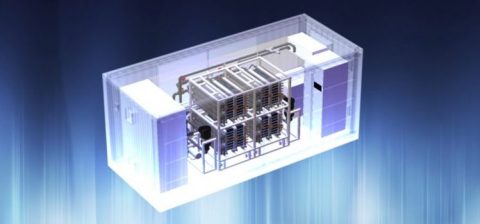
’s Werelds grootste batterij vangt in China schommelingen in windenergie op
7 juni 2016 – China krijgt ’s werelds grootste batterij: een van 800 megawattuur, gemaakt door het Amerikaanse UniEnergy Technology en het Chinese Rongke Power. De batterij moet de pieken en dalen in windenergie opvangen en het netwerk stabiel houden.
De enorme batterij moet een oplossing bieden voor het schommelende aanbod van windenergie op het schiereiland Dalian in het noorden van China. UniEnergy Technology en Rongke Power werkten sinds 2012 aan de zogenoemde Vanadium Flow Batteries (VFB) en kregen nu toestemming van de Chinese autoriteiten om de batterij te plaatsen. In 2020 moet de batterij klaar zijn.
Uit een bericht van UniEnergy Technology
‘(…) The battery arrays approved by the China National Energy Administration will be made up of ten (10X) 20MW/80MWh VFB systems deployed on the Dalian peninsula, which during extreme weather events has experienced stress on the electricity grid. After full commissioning, the VFB battery will be able to peak-shave approximately 8% of Dalian’s expected load in 2020. In addition, the large-scale battery will form an additional load center, which will enhance grid stabilization including securing the power supply and providing black-start capabilities in the event of emergency. (…)
UET President and COO Rick Winter stated: “This visionary project is a watershed moment for the energy storage industry, vaulting China’s electric grid into the 21st century, supplying tremendous resilience and enabling seamless deep penetration of renewables. The massive scale of the project was made possible by years of reliable field performance of vanadium flow batteries, and allows us to rapidly optimize our supply chain across our product lines.” (…)’
Uit een bericht van Engineering.com
‘(…) Unlike lithium-ion and other types of “enclosed” batteries, in which all the chemical elements are held inside the battery itself, flow batteries use a pair of external tanks to store the electrolytes and slowly pump the electrolytes into a stack of electrochemical cells where the chemical reactions create electricity. The benefits of this design are numerous: first, the storage capacity can be scaled up simply by using larger electrolyte tanks. Second, and perhaps more important, is that under a fault condition, the flow can be stopped, preventing a catastrophic thermal event. Third, flow batteries can be recharged over 15,000 times, compared to just 1,500 cycles for Li-ion batteries. The initial cost of flow batteries is around $300 – $500 per kWh, which is comparable to Li-ion. (…)’
Bronnen
UniEnergy Technology, 31 mei 2016: UniEnergy Technologies Strategic Partner to Deliver World’s Largest Battery
Duurzaam Bedrijfsleven, 6 juni 2016: Grootste batterij ooit wordt game changer voor energiesector
Engineering.com, 5 juni 2016: Massive 800 MegaWatt-hour Battery to Be Deployed in China
Foto: Rongke Power



